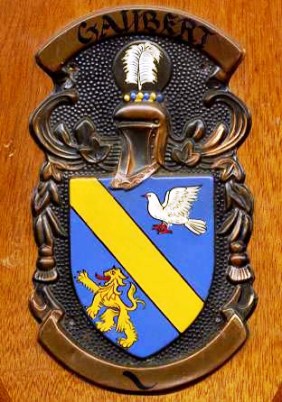This comprises the records from the IGI, the Huguenot Society, and papers from French national archives. The IGI shows many GAUBERTs although most are within the C 19th. Is that a consequence of persecution where a family 'disappears' from official records prior to, and immediately following, a period of civil unrest? The earlier records show a movement of the family name from Ansauville (Meurthe - et - Moselle) in the early C 18th. to Pordic and Binic (Cotes du Nord ) and then to Ceauce (Orne) by the mid C 19th. The earliest record that I have yet found of a Gaubert in France is that of Archbishop Gaillard de Saumate (1323-24) or Gaubert du Valof Arles (1324-41). You'll recall that the Huguenot Society papers mention a Cornet Louis GAUBERT. The archive material consists of extracts from books on ennobled families. It refers to the branches of the GAUBERTs (The Noble Families Of Poitou by Beauchet Filleau and correspondence from the Archive Departmentales in Poitier and Angouleme, the Biblioteque Nationale, and the Service Historique de L'Armee de Terre) and is reproduced in the following pages.
In 1702 the murder of the Abbe Chaila sparked a serious uprising of the Protestants in the Cevennes in Languedoc. This was suppressed by the end of 1704 but the last rebels held out until 1710. By this time many of our ancestors had been out of France for many years but they must have kept in touch with developments and felt deeply sympathetic for their relatives and co-religionists, all the more when a group of young 'inspires' came to London in 1706 and 1707.
What our specific ancestors thought we shall never know. The Threadneedle Street Consistory had already had to reproach patriotic Protestants who hoped for a French victory in the lengthy War of the Spanish Succession. England has been good to us, said the Consistory in effect, and we must be loyal to our new country.
The young people who came over from Languedoc were not necessarily congenial. They spoke in tongues in the way we call Pentecostal or charismatic and this was not at all the tradition of the refugees before the from the same part of France. It is likely that many of the stolid Normans metaphorically drew their skirts away from the way the refugees from the South West of France behaved. The parallels from our own tune seem obvious.
Gifts of prophecy had begun in the Dauphine in 1688 with a young shepherd girl called Isabeau Vincent calling shiners to repentance 'with her eyes closed'. She was imprisoned, where she continued to preach, and news of her spread, particularly when she was mentioned in the Lettres Pastorales, underground newsletters circulated throughout France by of Pierre Jurieu of Rotterdam.
Soon after a young labourer called Gabriel Astier, originally also from the Dauphine, travelled down the Rhone and prophesied in the Vivarais. The new movement spread like wildfire and in February 1689 soldiers fired on - and killed - hundreds of 'inspires' at Serre-de-la-Palle. They were confident that the Holy Spirit would keep them safe from the musket balls, and so had refused to disperse.
The gift of prophecy died away but in the autumn of 1700 it broke out again, particularly amongst young people. At first their messages were peaceful but imprisonment and accusations of witchcraft led to a change of line. It was Abraham Mazel of St-Jean-de-Gardonnenque who first called for a Holy War and that led pretty directly to the murder of the Abbe Chaila.
The following much longer list is intended purely as a guide to the names of those on whom there is some information in the much larger Dictionnaire des Camisards by Pierre Rolland, published by Les Presses du Languedoc in 1995 and covering more than 3150 people. It has not been possible to give details here and some of the names are so common that they appear in many of our trees but those who find names of interest should bear in mind that these people were from Languedoc - there is not likely to be much here for those descended from the Huguenots of the Atlantic coast, Normandy or the North East.
There are multiple entries (sometimes a dozen or more) to many of these surnames. Some of the women have feminine forms of the standard surname (eg, Jeanne Andrette, whose male relatives were called Andre). Some also had nicknames and it would be nice to know why David Couderc of St Martin de Lansuscle was called Tanglois'. Equally interesting is Jacques Magdanel. Born about 1679 in Londonderry, Northern Ireland, his parents are given as Rene Magdanel and Rose Moquelah, which may be a representation of McCullough. He was a grenadier in Coste's regiment from which he deserted, became a Camisard and was captured at the chateau of Prades. He was described as being of good height with chestnut hair and a round face. He was condemned to the galleys for life in October 1703 and died in hospital 25 December 1709.
The following are the surnames (and, in a few cases, titles) of all those listed in the Diictionnaire des Camisards: Some variants have been omitted:
Aubert, Gaubert
